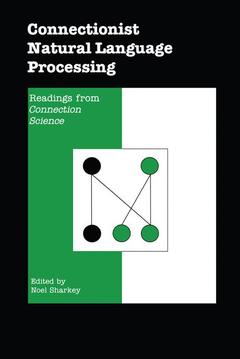Description
Connectionist Natural Language Processing, Softcover reprint of the original 1st ed. 1992
Readings from Connection Science
Coordinator: Sharkey Noel
Language: English
Publication date: 11-2012
375 p. · 16x24 cm · Paperback
375 p. · 16x24 cm · Paperback
Description
/li>Contents
/li>
Connection science is a new information-processing paradigm which attempts to imitate the architecture and process of the brain, and brings together researchers from disciplines as diverse as computer science, physics, psychology, philosophy, linguistics, biology, engineering, neuroscience and AI. Work in Connectionist Natural Language Processing (CNLP) is now expanding rapidly, yet much of the work is still only available in journals, some of them quite obscure. To make this research more accessible this book brings together an important and comprehensive set of articles from the journal CONNECTION SCIENCE which represent the state of the art in Connectionist natural language processing; from speech recognition to discourse comprehension. While it is quintessentially Connectionist, it also deals with hybrid systems, and will be of interest to both theoreticians as well as computer modellers.
Range of topics covered:
Range of topics covered:
- Connectionism and Cognitive Linguistics
- Motion, Chomsky's Government-binding Theory
- Syntactic Transformations on Distributed Representations
- Syntactic Neural Networks
- A Hybrid Symbolic/Connectionist Model for Understanding of Nouns
- Connectionism and Determinism in a Syntactic Parser
- Context Free Grammar Recognition
- Script Recognition with Hierarchical Feature Maps
- Attention Mechanisms in Language
- Script-Based Story Processing
- A Connectionist Account of Similarity in Vowel Harmony
- Learning Distributed Representations
- Connectionist Language Users
- Representation and Recognition of Temporal Patterns
- A Hybrid Model of Script Generation
- Networks that Learn about Phonological Features
- Pronunciation in Text-to-Speech Systems
1 Connectionism and Cognitive Linguistics.- 2 A Connectionist Model of Motion and Government on Chomsky’s Government-binding Theory.- 3 Syntactic Transformations on Distributed Representations.- 4 Syntactic Neural Networks.- 5 Incremental Syntactic Tree Formation in Human Sentence Processing: a Cognitive Architecture Based on Activation Decay and Simulated Annealing.- 6 A Hybrid Symbolic/Connectionist Model for Noun Phrase Understanding.- 7 Connectionism and Determinism in a Syntactic Parser.- 8 A Single Layer Higher Order Neural Net and its Application to Context Free Grammar Recognition.- 9 Connectionist Language Users.- 10 Script Recognition with Hierarchical Feature Maps.- 11 Learning Distributed Representations of Conceptual Knowledge and their Application to Script-based Story Processing.- 12 A Hybrid Model of Script Generation: or Getting the Best from Both Worlds.- 13 Identification of Topical Entities in Discourse: a Connectionist Approach to Attentional Mechanisms in Language.- 14 The Role of Similarity in Hungarian Vowel Harmony: a Connectionist Account.- 15 Representation and Recognition of Temporal Patterns.- 16 Networks that Learn about Phonological Feature Persistence.- 17 Pronunciation of Digit Sequences in Text-to-Speech Systems.
© 2024 LAVOISIER S.A.S.




